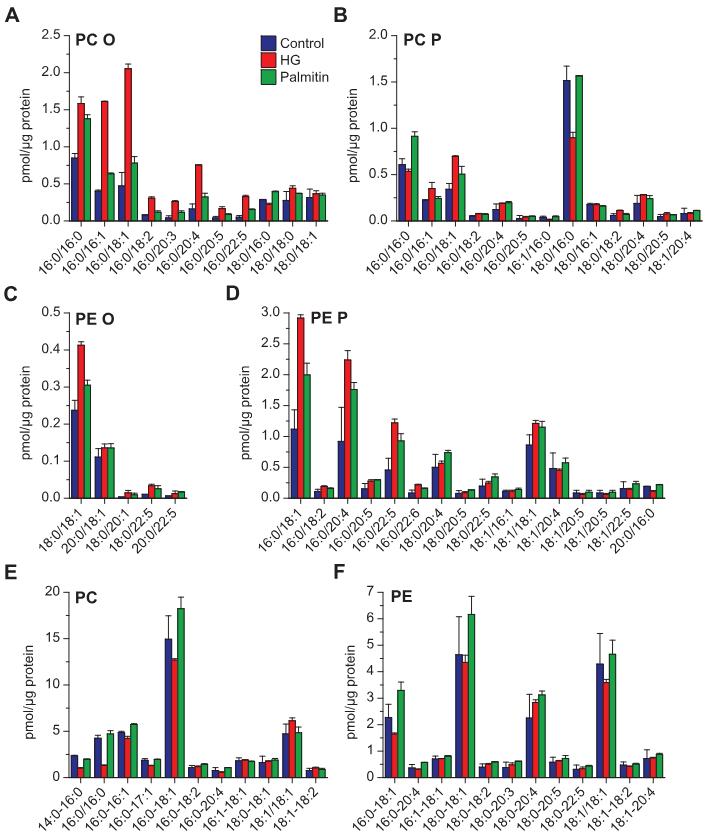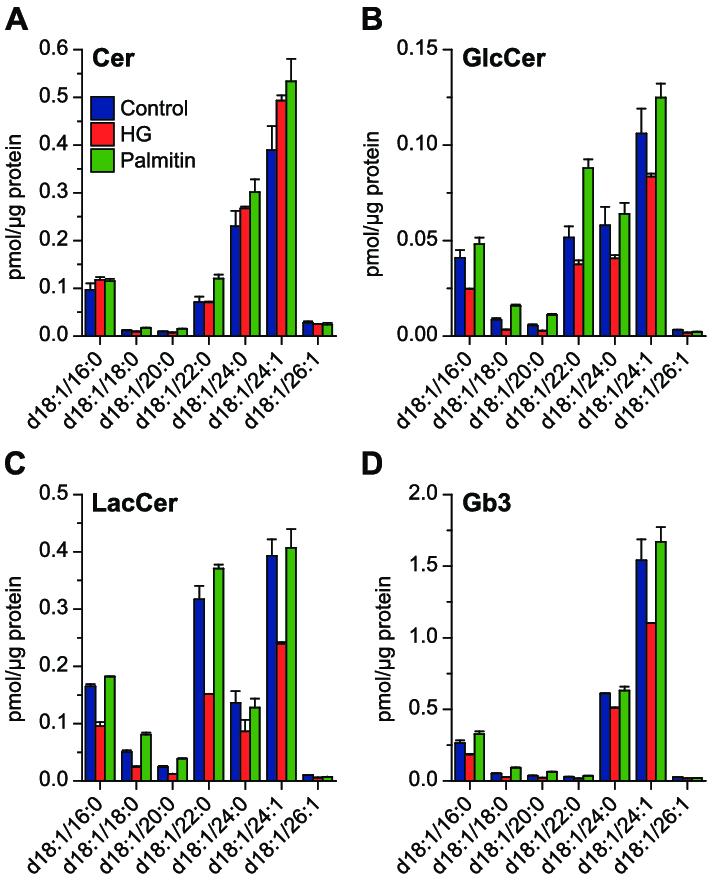- Service Details
- Case Study
What are Glycosphingolipids?
Glycosphingolipids are a type of complex lipid molecule found in cell membranes. They consist of a sphingosine or sphingoid base backbone, a fatty acid chain, and one or more sugar residues. The presence of sugar residues distinguishes glycosphingolipids from other sphingolipids.
Glycosphingolipids play essential roles in cell recognition, cell-cell communication, and cell signaling processes. They are particularly abundant in the outer leaflet of the plasma membrane, where they contribute to cell surface properties and interactions with the extracellular environment. Depending on their structure and composition, glycosphingolipids can serve as receptors for pathogens, participate in immune responses, and modulate cell adhesion and migration.
Examples of glycosphingolipids include cerebrosides, gangliosides, and globosides. These molecules are important in various physiological processes and have been implicated in several diseases, including lysosomal storage disorders and certain types of cancer.
Glycosphingolipids Analysis Services by Creative Proteomics
At Creative Proteomics, we specialize in providing comprehensive analysis services for glycosphingolipids, offering tailored solutions to meet the diverse needs of our clients. Our expertise in advanced analytical techniques and state-of-the-art instrumentation enables us to deliver reliable and insightful results across various project directions, including:
Glycosphingolipids Profiling: Comprehensive characterization of glycosphingolipid profiles in biological samples, including identification and quantification of glycosphingolipid species.
Structural Elucidation: Determination of glycosphingolipid structural features, such as fatty acid composition, sugar linkage patterns, and ceramide backbone variations, using advanced mass spectrometry techniques.
Disease Biomarker Discovery: Identification of glycosphingolipid biomarkers associated with various diseases, facilitating early diagnosis and prognosis assessment.
Therapeutic Target Validation: Evaluation of glycosphingolipid metabolism as a potential therapeutic target in disease conditions, aiding in the development and validation of targeted therapies.
Drug Efficacy Assessment: Assessment of glycosphingolipid alterations in response to therapeutic interventions, enabling monitoring of treatment efficacy and pharmacodynamic profiling.
Cellular Signaling Studies: Investigation of glycosphingolipid involvement in cellular signaling pathways and functional assays to elucidate their roles in physiological and pathological processes.
Microbial Glycosphingolipid Analysis: Characterization of glycosphingolipids in microbial systems, including bacteria, fungi, and viruses, to understand host-microbe interactions and pathogenicity mechanisms.
Customized Analysis Solutions: Tailored analysis services to address specific research questions and project requirements, with flexibility to accommodate diverse sample types and experimental designs.
List of Detectable Glycosphingolipids
| Ceramide | Glucosylceramide | Galactosylceramide | Lactosylceramide | Globotriaosylceramide (Gb3) |
| Globotetraosylceramide (Gb4) | Cerebrosides | Ganglioside GM1 | Ganglioside GM2 | Ganglioside GM3 |
| Ganglioside GD1a | Ganglioside GD1b | Ganglioside GD2 | Ganglioside GD3 | Ganglioside GT1a |
| Ganglioside GT1b | Ganglioside GQ1b | Ganglioside GQ1c | Ganglioside GQ1d | Ganglioside GT2 |
| Ganglioside GT3 | Ganglioside GT4 | Sulfatides | Globosides | Gangliosides |
Analytical Techniques for Glycosphingolipids Analysis
Liquid Chromatography-Mass Spectrometry (LC-MS): The Agilent 1290 Infinity II LC System coupled with the Thermo Scientific™ Orbitrap Fusion™ Tribrid™ Mass Spectrometer offers sensitive detection and precise identification of glycosphingolipids. The high-resolution capabilities enable detailed structural elucidation and quantitative analysis.
Tandem Mass Spectrometry (MS/MS): Utilizing the Thermo Scientific™ Orbitrap Fusion™ Tribrid™ Mass Spectrometer, MS/MS fragmentation provides valuable structural information on glycosphingolipids. This enables elucidation of fatty acid composition, sugar linkage patterns, and ceramide backbone variations with high precision.
High-Resolution Mass Spectrometry: With the Thermo Scientific™ Orbitrap Fusion™ Tribrid™ Mass Spectrometer, high-resolution mass spectrometry facilitates accurate detection of subtle structural differences and low-abundance glycosphingolipid species. This advanced technique ensures comprehensive characterization with utmost confidence.
Sample Requirements for Glycosphingolipids Analysis
| Sample Type | Recommended Volume |
|---|---|
| Serum | 100 µL |
| Plasma | 100 µL |
| Cerebrospinal Fluid | 100 µL |
| Tissue Homogenate | 20-50 mg |
| Cell Culture | 1-5 x 106 cells |
| Urine | 100-500 µL |
| Saliva | 100-500 µL |
| Brain Tissue | 20-50 mg |
| Liver Tissue | 20-50 mg |
| Kidney Tissue | 20-50 mg |
Deliverables for Glycosphingolipids Analysis
- Analysis Report: A concise report summarizing the experimental procedures, analytical methods, and key findings, focusing on identified glycosphingolipids and their potential significance.
- Processed Data: Processed data sets presenting quantification results, key spectral features, and identified glycosphingolipids, allowing for easy interpretation and comparison between samples.
- Interpretation Guidance: Interpretation guidance and recommendations highlighting the significance of identified glycosphingolipids in the context of the client's research objectives or specific applications.
- Consultation and Support: Ongoing consultation and support services to address any questions or concerns regarding the analysis results, ensuring clarity and understanding.
Applications of Glycosphingolipids Analysis
Biomedical Research: Glycosphingolipids play crucial roles in numerous biological processes, including cell signaling, cell recognition, immune response, and intracellular trafficking. Analyzing glycosphingolipid profiles can provide insights into the mechanisms underlying various physiological and pathological conditions, such as cancer, neurodegenerative diseases, metabolic disorders, and infectious diseases.
Disease Biomarker Discovery: Dysregulation of glycosphingolipid metabolism has been associated with several diseases. Glycosphingolipids can serve as potential biomarkers for disease diagnosis, prognosis, and therapeutic response monitoring. Analyzing glycosphingolipid profiles in biological samples, such as blood, urine, or tissues, can help identify disease-specific biomarkers and facilitate early detection and personalized treatment strategies.
Drug Discovery and Development: Targeting glycosphingolipid metabolism has emerged as a promising therapeutic approach for various diseases, including cancer, lysosomal storage disorders, and infectious diseases. Glycosphingolipid analysis can aid in drug discovery by identifying novel drug targets, evaluating drug efficacy and safety, and optimizing therapeutic interventions.
Functional Studies: Understanding the roles of glycosphingolipids in cellular signaling pathways and physiological processes requires detailed structural and functional characterization. Glycosphingolipid analysis techniques, such as mass spectrometry and chromatography, enable researchers to elucidate the molecular mechanisms underlying glycosphingolipid-mediated cellular functions, including cell adhesion, migration, apoptosis, and differentiation.
Microbial Pathogenesis: Glycosphingolipids are also present in microbial pathogens, where they play essential roles in host-pathogen interactions and virulence. Analyzing microbial glycosphingolipid profiles can provide insights into microbial pathogenesis mechanisms, host immune responses, and potential therapeutic targets for antimicrobial drug development.
Nutritional and Food Science: Glycosphingolipids are naturally occurring compounds found in various food sources, such as milk, eggs, and certain plant-derived foods. Analyzing glycosphingolipid composition in food products can contribute to nutritional assessment, food quality control, and the development of functional foods with potential health benefits.
Title: Impact of Alkylglycerol on Cellular Lipidome: Insights from Quantitative Lipidomics
Background
Understanding the influence of lipid precursors on cellular lipid metabolism is crucial for deciphering their roles in cellular functions and signaling pathways. Alkylglycerols, such as sn-1-O-hexadecylglycerol (HG), serve as precursors for ether-linked glycerophospholipids, but their specific effects on the lipidome remain unclear.
Sample
HEp-2 cells were utilized as the model system due to their relevance in toxin transport studies and previous experimental familiarity. Cells were treated with HG, palmitin, or control (ethanol) for lipid analysis.
Technical Methods
Cell Culture: HEp-2 cells were cultured in Dulbecco's modified Eagle medium supplemented with fetal calf serum, penicillin, and streptomycin.
Harvesting of Cells for Lipidomics: Cells were treated with HG, palmitin, or control, harvested, washed, and lysed. Protein content was quantified using a BCA protein assay kit.
Annotations of Lipid Species: Lipid species were annotated according to IUPAC recommendations, with ether-linked GPs and glycosphingolipids specified. Lipid extraction was performed using a modified Folch procedure.
MS Analyses: Lipid species were analyzed using a hybrid triple quadrupole/linear ion trap mass spectrometer. Shotgun analysis and reverse phase ultra-high pressure liquid chromatography were employed for lipid quantification and identification.
Data Processing: MS data files were processed using Lipid ProfilerTM and MultiQuantTM software. Lipids were normalized to internal standards, and concentrations were presented as pmol/mg protein. Quality control samples were used to monitor the overall quality of lipid extraction and MS analysis.
Results
- Treatment with HG led to significant alterations in the cellular lipidome, including increased levels of ether-linked PC and PE species with 16:0 in the sn-1 position.
- Notably, HG treatment reduced glycosphingolipid levels despite increased ceramide levels, suggesting complex regulatory mechanisms.
- HG treatment also resulted in a dramatic increase in PI and LPI levels, indicating potential effects on cellular signaling and metabolism.
- Conversely, palmitin treatment showed similar trends but to a lesser extent, indicating differential effects compared to HG treatment.
- No major changes were observed in other lipid classes or species following treatment with either HG or palmitin, underscoring the specificity of HG's effects on the cellular lipidome.
 Quantitative analysis of glycerophospholipids after HG or palmitin treatment. The major species of (A) PC O, (B) PC P, (C) PE O, (D) PE P, (E) PC and (F) PE, in HEp-2 cells treated with HG (20 mM), palmitin (20 mM) or ethanol (0.1%, as control) for 24 hours. The species shown here are species comprising more than 1% of the total mass of the ether lipids and more than 2% of PC and PE for at least one of the samples.
Quantitative analysis of glycerophospholipids after HG or palmitin treatment. The major species of (A) PC O, (B) PC P, (C) PE O, (D) PE P, (E) PC and (F) PE, in HEp-2 cells treated with HG (20 mM), palmitin (20 mM) or ethanol (0.1%, as control) for 24 hours. The species shown here are species comprising more than 1% of the total mass of the ether lipids and more than 2% of PC and PE for at least one of the samples.
 Quantitative analysis of ceramide and glycosphingolipids after HG or palmitin treatment. The major species of (A) Cer, (B) GlcCer, (C) LacCer, and (D) Gb3 in HEp-2 cells treated with HG (20 mM), palmitin (20 mM) or ethanol (0.1%, as control) for 24 hours. The species shown here are species comprising more than 1% of the total mass of any of the classes.
Quantitative analysis of ceramide and glycosphingolipids after HG or palmitin treatment. The major species of (A) Cer, (B) GlcCer, (C) LacCer, and (D) Gb3 in HEp-2 cells treated with HG (20 mM), palmitin (20 mM) or ethanol (0.1%, as control) for 24 hours. The species shown here are species comprising more than 1% of the total mass of any of the classes.
Reference
- Bergan, Jonas, et al. "The ether lipid precursor hexadecylglycerol causes major changes in the lipidome of HEp-2 cells." PloS one 8.9 (2013): e75904.




